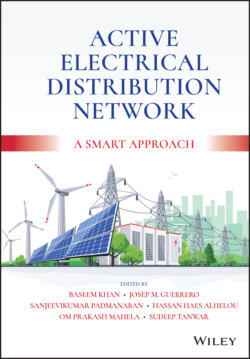Читать книгу Active Electrical Distribution Network - Группа авторов - Страница 45
2.4 Importance of Feeder Segregation in the Context of Current Status
ОглавлениеThe Indian agricultural sector is the third largest consumer of electricity after the industrial and domestic sectors but the revenue realization from this sector is very low [36]. The share of agriculture in total electricity consumption is significant, i.e. 23% in 2011–2012, 18.08% in 2017–2018, and 7.69% in 2018–2019, but the share of the agriculture sector in total revenue generation is very poor; it was only 7% in 2011–2012. This reason and the reasons explained in Section 2.1 shift the focus of the Indian Government to give the utmost urgent attention to the agriculture sector. As a result, the Indian Government has initiated the concept of agriculture feeder segregation.
The Government of India thought to bring up a national level scheme that will guide, monitor, finance, and promote the process of feeder segregation in different agricultural intensive states. Thus, the Ministry of Power requested the forum of regulators (FOR) to work upon a framework to draw up a scheme at national level for feeder segregation of rural and agricultural consumers and suggest measures for effective metering. The report recommended that a national level program for feeder segregation be implemented in a calibrated manner while allowing states to have the flexibility to design the project to suit their specific requirements, subject to adequate power being available at the national level.
Although various Indian states, as explained, have implemented the process of feeder segregation, their rate of implementation is very slow. Many Indian states have even not thought of the initiation of the segregation process to date. However, Indian utilities that have adopted the process of segregation are not able to harness all such benefits that they had envisaged through feeder segregation. The actual theft or the possibility of theft of line conductors, transformers, and other electrical elements fitted in to the agriculture feeder is one of the main hurdles behind all the above issues. None of the utilities have claimed that they have found the trick to handle this issue of theft, and no researcher has yet published any article proposing a solution to deal with the issue of theft. These facts are demotivating and weaken the confidence of Indian utilities to take part in the feeder segregation plan.
Hence the process of network reconfiguration can be used to address one of the biggest challenges in promoting a national level scheme. Apart from its basic objective, the inclusion of network reconfiguration will also help in reducing technical losses, improving voltage profile, minimizing outages, reducing device failures, minimizing overloading, smoothing peak demand, and increasing the network reliability. It will further contribute toward the national target of achieving AT&C loss minimization. The outcomes of this proposed chapter will give thrust to the implementation of the Feeder Segregation Plan (FSP) across different Indian states. It will enhance the confidence of various Indian utilities and provide motivation in implementing the FSP.
